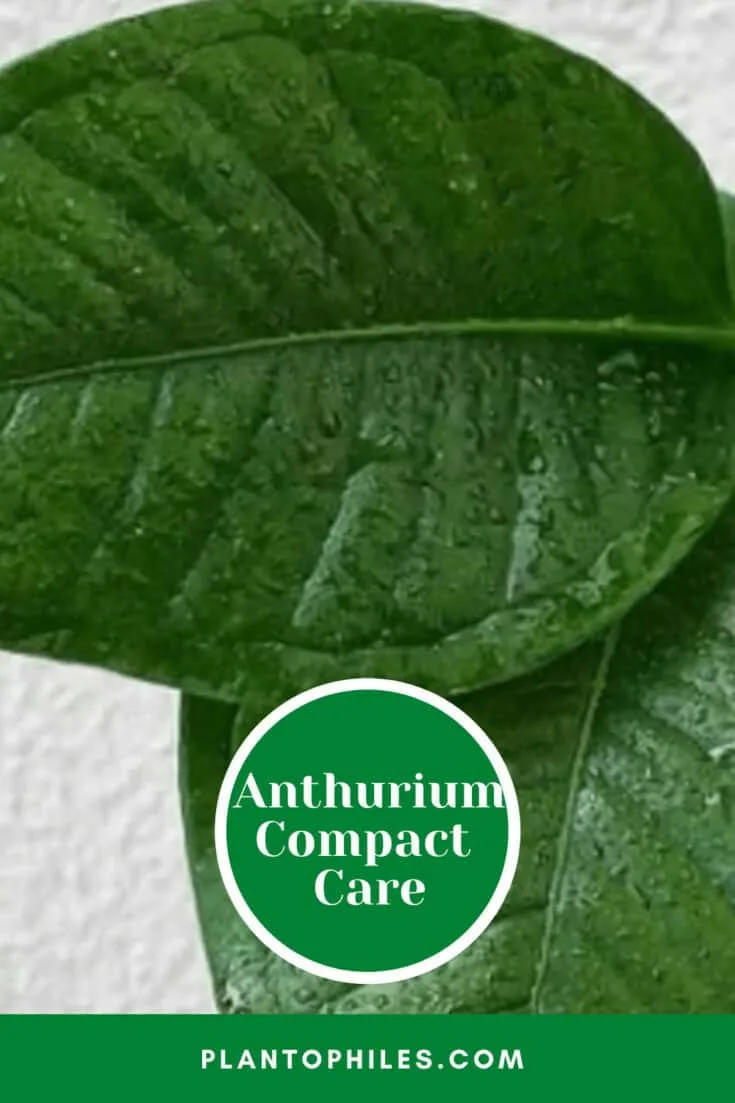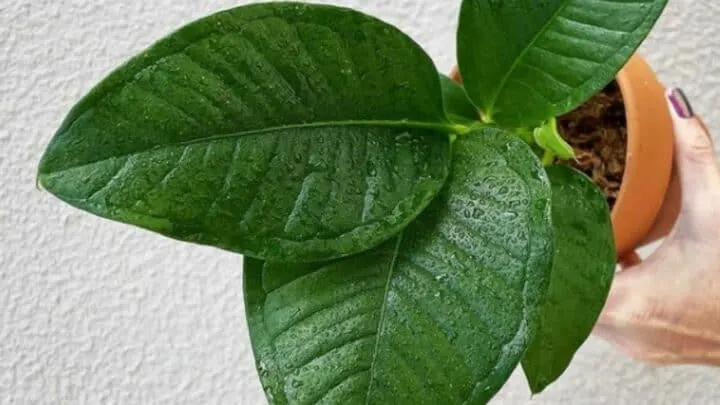Anthurium Compact, also known as Mini Anthurium, is a plant that belongs to the family Araceae or, more commonly, arums.
Its botanical name is Anthurium Andraneum and belongs to the tropical regions of South America.
The plant is also known as the flamingo flower, as it bears bright pink shaded flowers that stand firmly against the foliage.
Rising from the center of the plant, the leaves are mostly heart-shaped with a length of approximately eight inches and extremely long stems.
It is very easy to grow as this plant requires little attention and effort.
All you need to do is ensure the right space and take out a little time to feed it with water and fertilizer every once in a while.
Being very user-friendly, they will do great even in a very small pot. As the plant grows, you can either let them outgrow the pot or shift in a larger pot, if you like.
As the leaves grow in clusters, the plant looks exquisite and is further enhanced with small flowers that grow in various shades such as yellow, pink, and purple.
Since this plant grows with minimal effort and in a small space, you can easily begin your gardening experiences with this one.
This guide consists of all the tips and tricks necessary to ensure the optimum growth of your Anthurium Compact.
Table of Contents
Anthurium Compact Plant Care
Anthurium Compact loves to bright indirect sunlight. Make sure to use well-draining soil with a pH ranging between 5.5 and 6.5. Water your Anthurium Compact once the soil’s top 2 inches (5cm) are dry to avoid overwatering. Feed this plant once monthly with half-strength fertilizer in Spring and Summer. Keep the temperature between 70-degree to 90-degree Fahrenheit (21.1 to 32.2 degrees Celsius). Humidity levels should be at 70% or more for an ideal environment but it will tolerate less.

Anthurium Compact Care
Soil
As this plant is mostly grown indoors, make sure that you have a pot that has efficient and large drain holes. It is extremely crucial for the soil to drain water; otherwise, it will rot.
Excess water present in the soil can lead to pests and damaged roots. You can make your ideal soil mix for this plant by simply combining sand with peat moss.
Anthuriums require a slightly acidic pH ranging from 5.5 – 6.5. Raising the pH of the soil above 6.5 can result in deterioration of the whole plant as the soil will turn basic.
However, if you are growing your Anthuriums outdoors, you will have to bring them indoors as the weather turns cold.
Also, make sure to combine the soil with organic matter to ensure the proper growth of the plant. If the soil you are using retains a lot of water, you may have to consider raised bed gardening.
Raised bed gardening aims to drain the soil quickly as the soil level is elevated to a few inches which helps to keep the soil from retaining water.
Water
Ensuring the perfect amount of water to your Anthuriums can be a challenge at times.
The first thing to keep in mind when it comes to watering this plant is to prevent the rotting of the roots.
Roots of Anthurium Compact are highly vulnerable to rot if they’re overwatered. However, on the contrary, with too little water, the leaves are exposed to discoloration.
To tackle this, you need to check the first inch of the soil with two fingertips. If the soil’s top 1 inch is dry, then water your plant.
Moreover, in summers, you will need to check on your plant more often as the soil will dry out quickly. In winters, this plant will require less water due to less sunlight exposure.
Light
Although the Anthurium Compact requires bright sunlight, it should always be indirect. Direct sunlight can very quickly cause the leaves to burn, wilt, or lose their bright green color.
Therefore, you can place your plant in a window facing east so that it receives bright indirect light from the sun.
It is always the best practice to keep your plant away from the scorching sun as the strong rays of the sunlight will rot the leaves in no time.
Temperature
Warm temperature favors the growth of the Anthurium Compact; therefore, they will show substantial growth at a temperature of 70-degree to 90-degree Fahrenheit (21.1 to 32.2 degrees Celsius).
As long as the temperature’s above 70-degree Fahrenheit, the plant will sustain itself. However, below this temperature, it will start to rot due to extreme sunlight.
Moreover, do not keep your plant beside a heater or an air conditioner. The heater will quickly make the plant hotter, which can result in discoloration of the leaves.
On the other side, the air conditioner will make it too cold and, therefore, prone to temperature shock.
Humidity
Keep the humidity at 70% if you want to provide the best possible environment for the Anthurium Compact.
While outdoor plants can sustain their humidity through the environment, ensuring the right amount of humidity for indoor Anthuriums can be pretty difficult.
Anthuriums thrive on humidity, and therefore, you may have to keep a check every once in a while to see how your plant is doing.
To ensure the proper level of humidity indoors, you can use a pebble tray under the plant. Moreover, misting will also work great for the leaves to retain moisture.
A relatively expensive but useful method is to use a humidifier as it helps in keeping the correct humidity level inside your house.
Fertilizer
When it comes to fertilizing your Anthurium Compact, always dilute the fertilizer because this plant is highly sensitive to strong doses.
If you want to encourage your Anthurium Compact’s growth, use a fertilizer with high phosphorus levels. Using a fertilizer once a month will help the plant to bloom and maintain the color of the leaves.
Moreover, the fertilizer rich in phosphorus also helps keep the insects away.
It is recommended to use the fertilizer at least once a month in summer as it is the growing season for the plant. However, in winters, you can reduce the frequency to once every two months.
Repotting
You know it is time to repot when the roots of your Anthuriums are coming out of their current pot.
All you need is a larger pot (not too large; only 2 inches greater in length than the previous pot) and a pack of potting mix.
Anthurium Compact does not require repotting very frequently. Rather, you will need to transfer it in a larger pot once in two years.
After placing the plant in its new pot, fill it with 1/3rd of the potting mix and let it rest for a few weeks. Meanwhile, water it diligently and expose it to proper indirect sunlight.
After a few weeks, when new roots are rising from the soil, pour the remaining potting mix, water it, and expose it to indirect sunlight.
Pruning
While pruning your Philodendron, you need to take care of a couple of things;
- Prune only in the months of active growth so that the plant has the potential to grow again. These active months are from spring to summer.
- Remove the discolored leaves and spiky buds at first.
- Use thick hand gloves while pruning so that you are protected against allergies.
- Use clean and disinfected instruments to prune.
Propagating
To propagate Anthurium Compact, the most important thing you need to have is the rooting hormone. You can get it from a gardening store or else, you can also make it at home with the help of a few ingredients.
The first way to propagate is by using air roots that rise above the soil. Dip these roots in the rooting hormone and submerge them in the new potting mix.
After a few weeks, these air roots should give rise to more roots and stems.
The second way, however, is by using stem cuttings of the plant. Choose the stem, which is six to eight inches long and contains a few sets of leaves.
Cut it at an angle, dip in the rooting hormone before placing it in the soil up to the level of the first leaves. Make sure to give ample water at the start, and mist the plant once a week to ensure humidity.
Soon after, more shoots should follow.
View this post on Instagram
Common Problems for Anthurium Compact
The most common insects your Anthurium Compact may be affected by are spider mites, thrips, scales, and whiteflies.
However, there are some precautions to note to help keep your Anthurium Compact safe.
Make sure to look after your soil. As mentioned earlier, it should be well-drained and enriched with compost.
If the soil retains water and remains wet for a long time, your plant will be highly vulnerable to these insects. Hence, use a pot with drain holes that are large in size.
If your plant somehow gets affected by insects such as thrips and mealybugs, wash them away with a fast stream of water so that the insects slide from the plant.
After that, use a clean cloth to wipe the leaves.
Frequently Asked Questions About Anthurium Compact
What impact does the Anthurium Compact have on my pet dog?
Anthuriums are highly toxic to children and pets, as inhaling the smell or ingesting a small fragment of the leaf can lead to poisoning, abdominal issues, and difficulty in breathing. Therefore, always keep your Anthurium away from the reach of children and animals.
When should you repot your Anthurium Compact?
There is absolutely no need to repot your plant frequently as the plant may lose its strength with every shift. However, Anthuriums should be repotted when they have outgrown their current pot, and the roots are pouring out of their space.
What can Anthuriums be used for?
Since the plant has heart-shaped leaves with vibrant colors, which gives a welcoming feel, this plant can be a great choice for a housewarming gift. As the plant is low maintenance and does not need much space, it can also be a good way to brighten up your patio.
Should I cut my Anthurium Compact’s brown leaves?
Definitely, yes. It is always the best practice to prune the unwanted leaves. Also, pruning brown and black leaves will prevent the spread of these discolored leaves.
How should I prune my plant?
When it comes to pruning your plant, always make sure that you are wearing gloves so that you don’t get harmed by any spike or insect. Moreover, if you are unable to snip off the stem with your hand, consider using a secateur.
Why are my Anthurium blooms very small?
If you witness that the flowers of your Anthuriums are shrinking or not growing to their optimum size, it may be because of strong sunlight. Make sure that your plant is not kept under direct sunlight.
Should I use coffee grounds on my plant?
Since the Anthurium Compact requires a rough and acidic potting mix, using coffee grounds is not a good choice as it may complicate the pH of the soil and hinder the proper growth of the plant.
Conclusion
Anthurium Compact, known for its small size and vibrant colors, can be grown with little effort and is sure to captivate the attention of your guests.
It can be placed on the center of a table or beside the couch, giving your place a fantastic feel.
With its beautifully shaded flowers and bright green leaves, this plant will give a wonderful look when placed in a black container, in contrast with the color of the foliage.

Daniel has been a plant enthusiast for over 20 years. He owns hundreds of houseplants and prepares for the chili growing seasons yearly with great anticipation. His favorite plants are plant species in the Araceae family, such as Monstera, Philodendron, and Anthurium. He also loves gardening and is growing hot peppers, tomatoes, and many more vegetables.


